Tyco Safety Sensormatic AMS1080 ANTI THEFT DEVICE User Manual AMS 1080 Detection System
Tyco Safety Products/Sensormatic ANTI THEFT DEVICE AMS 1080 Detection System
USERS MANUAL
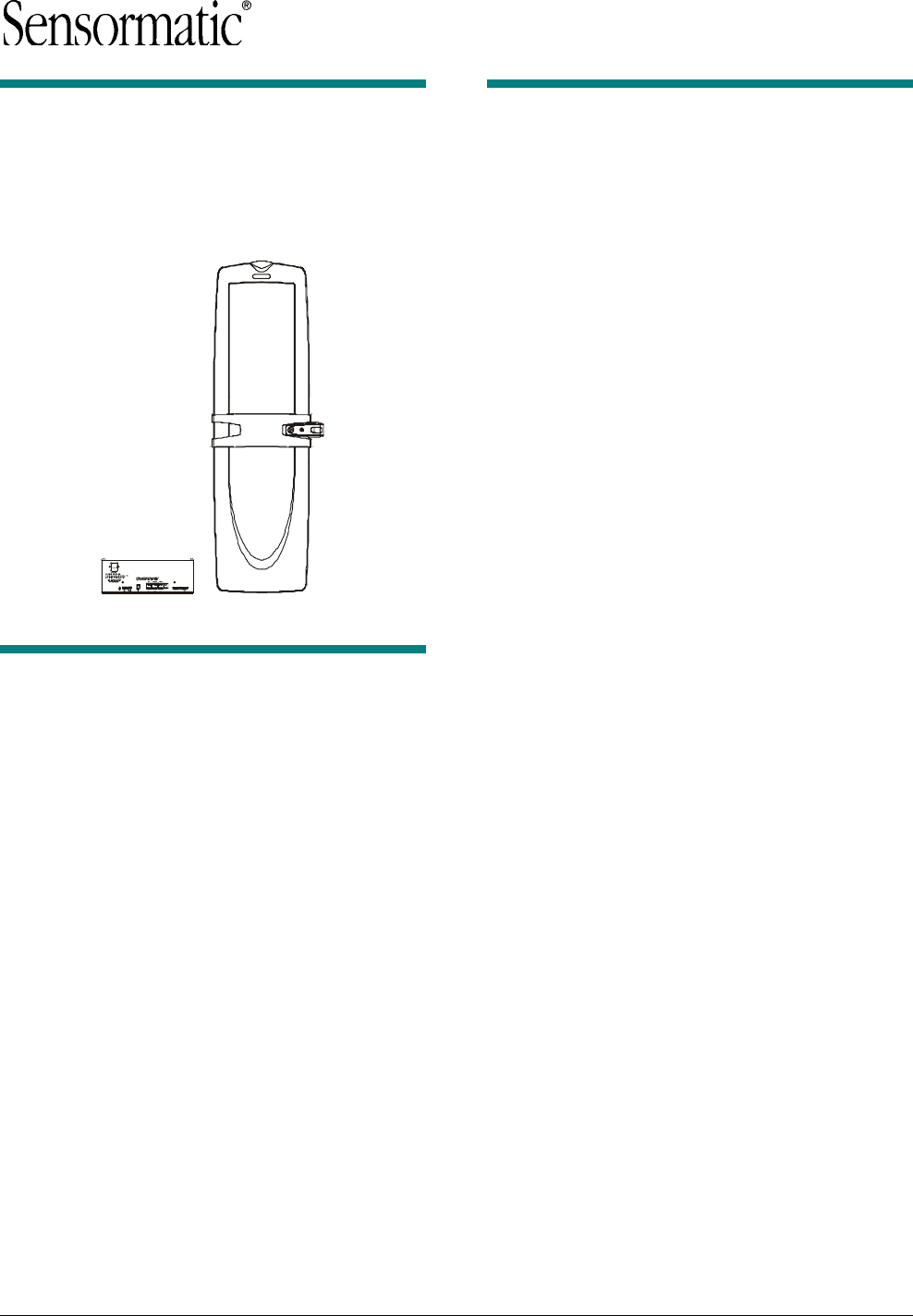
AMS-1080 DETECTION SYSTEM 8200-0418-01, REV. A
INSTALLATION AND SERVICE GUIDE 1 of 18
AMS-1080
Detection System
Installation and Service Guide
Contents
To the Installer....................................................... 1
About the Product.................................................. 2
Device Connections .............................................. 4
Installation Features.............................................. 6
Service Features ................................................... 7
Installation Requirements...................................... 8
AMS-1080 Antenna Installation............................. 9
Against a Wall or Counter .................................. 9
To a Railing Post.............................................. 10
Controller Installation........................................... 12
AC Hookup .......................................................... 12
System Setup ...................................................... 13
Antenna Connections....................................... 13
Software Selections ......................................... 14
Verifying Operation.............................................. 14
Troubleshooting................................................... 15
Fuse Replacement .............................................. 17
Specifications ...................................................... 17
Declarations ........................................................ 18
© 2004 Sensormatic
To the Installer
This installation and service guide explains how to
install, setup, and service the AMS-1080 detection
system.
Parts required to install this system are:
- AMS-1080 Controller
- AMS-1080 Controller Mounting Kit
0352-0203-01 (optional)
- AMS-1080 Antenna(s)
- AMS-1080 Antenna Counter Mounting Kit(s)
0352-0199-01 or Pole Mounting Kit(s)
0352-0198-01
- ZKRANGER-DG Ranger antenna kits, as
required (purchase separately).
Other documents that may be required for
installation are:
- AMS-1080 Planning Guide, 8200-0418-02
- ZKRANGER-DG Ranger Installation Guide,
8200-0452-01
- AMS-1080 Theory or Operation, 8200-0418-03.
Note:
- Because customer requirements dictate the
placement of system components, your
Sensormatic representative will supply this
information separately.
- If this product was installed in a European
Union or European Free Trade Association
member state, please give the Declaration of
Conformity included with this product to the
manager or user. By law, this information must
be provided to the user.
- The controller is cooled by a fan that is factory
set to 240Vac. If using 120Vac, remove the
cover from the controller and change fan
jumpers to 120Vac. See label inside the
controller for jumper locations.
- Install the AMS-1080 antenna at least 5cm (2in)
from metal surfaces.
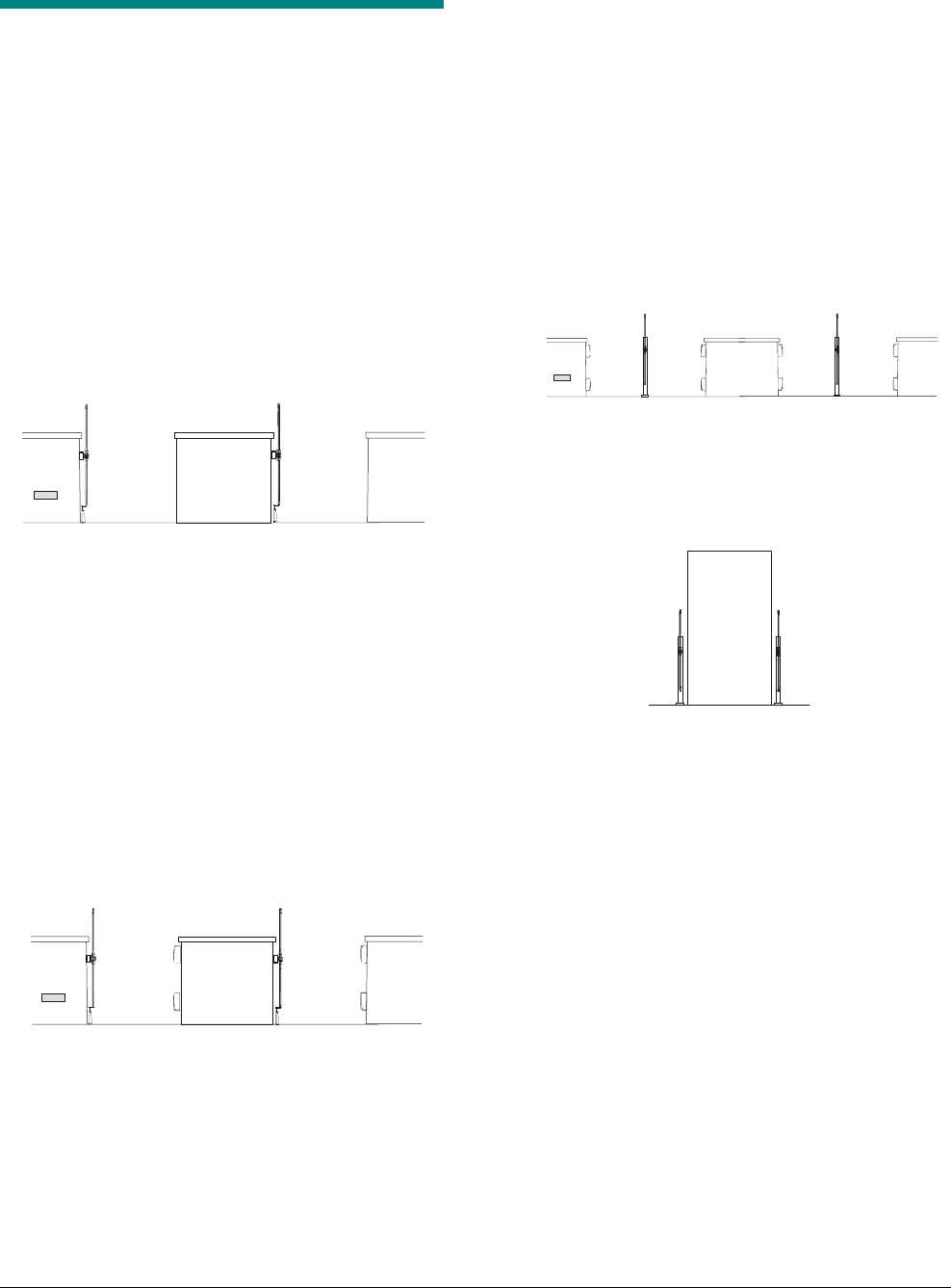
AMS-1080 DETECTION SYSTEM 8200-0418-01, REV. A
INSTALLATION AND SERVICE GUIDE 2 of 18
About the Product
The AMS-1080 detection system detects EAS
tags/labels in food store checkout aisles, with each
aisle independently supported. The detector
consists of a controller and one of the following
antenna combinations:
- Up to two individual aisles supported with
transceivers.
For this setup, an AMS-1080 antenna is set up
as a transceiver in each aisle. The antenna
furthest from the controller requires a trench to
route its cables to the controller.
The AMS-1080 antennas in each aisle can be
set to alarm independently.
- Up to two individual aisles (A and B) supported
with improved detection or with backfield
reduction.
For improved detection, an AMS-1080 antenna
is set up as a transceiver in each aisle and a
pair of Ranger receive antennas (purchased
separately) are set up opposite the antenna.
For backfield reduction, the AMS-1080 antenna
is set up as a transmitter instead.
The AMS-1080 antennas in each aisle can be
set to alarm independently.
Antennas furthest from the controller require a
trench to route their cables to the controller.
- Up to two individual pairs of adjacent aisles
(A1/A2 and B1/B2) supported.
For each adjacent aisle, an AMS-1080 antenna
is set up as a transmitter on a railing post
between the two aisles and a pair of Ranger
receive antennas (purchased separately) are
setup opposite the each side of the antenna.
The alarm lamp in the AMS-1080 antenna
automatically signals which aisle a security
tag/label was detected.
Antennas furthest from the controller require a
trench to route their cables to the controller.
- Two AMS-1080 antennas set up at a doorway
either in alternating transmit-receive or dual
transceiver configurations. Alarms in both
antennas activate simultaneously.
A B
A B
A1 A2 B1 B2

AMS-1080 DETECTION SYSTEM 8200-0418-01, REV. A
INSTALLATION AND SERVICE GUIDE 3 of 18
Basic Operation
The AMS-1080 detector deters theft by activating
an alarm when it detects the unique response of an
active Ultra•Max hard plastic tag or disposable
label.
To detect a tag/label, AMS-1080 antenna(s)
connected to the controller emit a magnetic field
close to the tag/label’s natural frequency causing it
to vibrate or “ring” at the frequency of the field.
When the field is removed, energy in the tag/label
dissipates causing an exponential ring down.
The AMS-1080 antenna(s)—and ferrite (Ranger)
antennas, if used—pick up incoming signals and
send them to the controller which processes them
to determine if they are indicative of ring down. If
they are, then the controller activates an
audio/visual alarm indicator at the top of the AMS-
1080 antenna that detected the tag/label.
When the AMS-1080 antenna is positioned
between two adjacent checkout lanes, the visual
alarm indicator can be set to indicate the aisle
where the active tag was detected.
AMS-1080 Controller Features
The AMS-1080 controller features the following:
- Independent Tx and Rx connections that
support two transmitters and four receivers
- Supports up to two noise canceling coils
- Controls pedestal alarms
- Has “ac line synchronization” and “tag too close”
functions.
- Supports wired transmitter synchronization
- Is adjusted either on-site or remotely using a
laptop computer and AMS-1080 service
configurator software
- Built-in mounting flange enables it to mount
vertically to a wall or inside the checkout
counter. The controller can also rest on a shelf.
AMS-1080 Antenna Features
The AMS-1080 antenna features the following:
- Emits the detection field and receives the
tag/label signal
- Figure “O” and Figure “8” transmit coils in the
antenna combine to produce a field that
alternates between the top and bottom of the
antenna. These coils can also be set for
maximum field in the top of the antenna only or
the bottom of the antenna only. Maximum
operating current is 15A
- Mounts to the side of a wall or counter, or to a
railing post using hardware supplied
- Has an alarm lamp for each side of the antenna
- Has a “transmitter on” lamp that lights when the
transmitter is on
- Has two hardwired cables that connect to the
controller. Cable length is 7.6m (25ft). DO NOT
CUT! Shorter cables can reduce operating
performance.
Ranger Antenna Features
- Only receives the tag/label signal
- Mounts to a wall or counter opposite the AMS-
1080 antenna
- These ferrite antennas connect together as a
pair and have a hardwired cable that connects
to a “Auxiliary Receive” connector on the
controller.

AMS-1080 DETECTION SYSTEM 8200-0418-01, REV. A
INSTALLATION AND SERVICE GUIDE 4 of 18
Device Connections
PEDESTAL ALARM 1 (P55A)
Pin 1 - White with an 'X' (Shield)
Pin 2 - Yellow (Audio 1)
Pin 3 - Orange (Alarm 1B)
Pin 4 - Blue (Alarm 1A)
Pin 5 - Brown (12V)
Tx 1 TRANSMIT ANTENNA (P58)
Pin 1 - Black (Figure-8 return)
Pin 2 - Red (Antenna A2)
Pin 3 - White with an 'X' (Shield)
Pin 4 - Green (Aiding return)
Pin 5 - White (Antenna A1)
Tx 2 TRANSMIT ANTENNA (P59)
Pin 1 - Black (Figure-8 return)
Pin 2 - Red (Antenna B2)
Pin 3 - White with an 'X' (Shield)
Pin 4 - Green (Aiding return)
Pin 5 - White (Antenna B1)
AUX. RECEIVE (P56A)
Pin 1 - Black (Ant C1, noise can.)
Pin 2 - Red (Ant C1 return)
Pin 3 - Green (Ant C2)
Pin 4 - White (Ant C2 return)
Pin 5 - 'X' (Shield)
AUX. RECEIVE (P56B)
Pin 1 - Black (Ant D1, noise can.)
Pin 2 - Red (Ant D1 return)
Pin 3 - Green (Ant D2)
Pin 4 - White (Ant D2 return)
Pin 5 - 'X' (Shield)
PEDESTAL ALARM 2 (P55B)
Pin 1 - White with an 'X' (Shield)
Pin 2 - Yellow (Audio 2)
Pin 3 - Orange (Alarm 2B)
Pin 4 - Blue (Alarm 2A)
Pin 5 - Brown (12V)
Rx 1 RECEIVE ANTENNA (P53A)
Pin 1 - Black (Ant A1)
Pin 2 - Red (Ant A1 return)
Pin 3 - Green (Ant A2)
Pin 4 - Gray or White (Ant A2 return)
Pin 5 - Violet / 'X' (Shield)
Rx 2 RECEIVE ANTENNA (P53B)
Pin 1 - Black (Ant B1)
Pin 2 - Red (Ant B1 return)
Pin 3 - Green (Ant B2)
Pin 4 - Gray or White (Ant B2 return)
Pin 5 - Violet / 'X' (Shield)
RS-232 SERVICE (RJ-22)
Pin 1 - Rx
Pin 2 - Tx
Pin 3 - Ground
Pin 4 - Ground
RS-485 NETWORK (P8)
Pin 1 - Black
Pin 2 - Red
Pin 3 - X (Shield)
WIRED Tx SYNC (P2)
Pin 1 - Black (Tx Burst High)
Pin 2 - Red (Tx Burst Low)
Pin 3 - Green (Arm High)
Pin 4 - White (Arm Low)
Pin 5 - 'X' (Shield)
AC IN
(120Vac/
240Vac)
LED
System Status
Indicator

AMS-1080 DETECTION SYSTEM 8200-0418-01, REV. A
INSTALLATION AND SERVICE GUIDE 5 of 18
Transmit Antenna (Tx1, Tx2)
These two connectors each receive a transmit
cable from an AMS-1080 antenna.
Receive Antenna
(Rx1, Rx2, Aux A, Aux B)
Connectors Rx1 and Rx2 each receive a receive
cable from an AMS-1080 antenna or from a ferrite
(Ranger) antenna. Connectors Aux A and Aux B
each receive a cable only from a ferrite antenna.
Each connector has a Coil 1 input (top of pedestal)
and a Coil 2 input (bottom of pedestal).
These connectors default to Rx function. Any
adjustment to default settings must be saved in the
controller for use on the next power cycle or
system reset.
When using noise coils, note the following:
- A noise coil is used to cancel specific noise
interfering with detector operation.
- Noise coils only connect to the Coil 1 input of
the Aux A or Aux B connectors on the controller.
- To accept a noise coil, the Coil 1 part of each
auxiliary input must be reconfigured to noise
canceling mode using the service configurator.
- By moving a noise coil around while monitoring
power levels on the service configurator, a
location can be found where noise cancellation
is best. This is where the coil is likely to be
installed.
- The location for noise coil installation must be
practical as well as yield satisfactory results.
RS-232 Network (Service Connection)
This 4-pin modular connector receives the cable
from a modem or laptop computer used to
communicate with the controller.
RS-485 Network
This connector supports network communication
and Sensormatic alarm logging and traffic flow
devices.
Wired Tx Sync
The wired Tx sync function is used to eliminate
interference from nearby detectors and deactiva-
tors. A wired sync device connected to this port is
automatically used as the timing reference for
system functions.
Note: The controller also provides for slower
sequencer level synchronization to allow two
antennas to be placed next to each other when
driven by different controllers.

AMS-1080 DETECTION SYSTEM 8200-0418-01, REV. A
INSTALLATION AND SERVICE GUIDE 6 of 18
Installation Features
Controller
- Ac synchronization
- Transmitter current control
- Integrated mounting flange to mount it to a
vertical surface inside the checkout counter.
Antenna
- 7.6m (25ft) Tx burial rated cable
- 7.6m (25ft) Rx burial rated cable
- Mounts to the checkout counter or pole
- No antenna tuning required.
Auto Synchronization
Auto synchronization occurs during power up or
system reset. Auto sync can have different
outcomes depending on whether or not nearby
EAS transmitters are detected, they are properly
aligned to the ac-derived timing of the controller, or
too much ambient noise exists.
No transmitters detected. During initialization, the
controller determines if EAS transmitters are
nearby. If none are found, transmitter delay is set
to zero if this is the initial power on, or set to the
value stored in the controller if not the initial power
on.
Transmitters detected:
- Transmitters detected and aligned. If
transmitters are correctly aligned, the
transmitter delay is calculated and stored in the
controller for reference.
- Transmitters detected and not aligned. If
transmitters are not aligned, the transmitter
delay is set to zero if this is the first power on of
the controller, or set according to the value
stored the controller if not the initial power on.
Too much ambient noise. During initialization, the
controller locates other nearby EAS transmitters.
- If ambient noise prevents the controller from
locating nearby EAS controllers and if this is the
first power on of the controller, transmitter delay
is set to zero.
- If this is not the first power on of the controller,
the zero crossing delay stored in the controller
is used.
Note: The controller stores the zero crossing delay
for when the controller could not determine a
reliable lock during subsequent power cycles.
Instead of using zero for the delay, the controller
uses the stored zero crossing delay.
Wired Synchronization
If a wired Tx sync device is connected to the
controller, the controller automatically uses its
signal as the timing reference instead of the ac
line. The service configurator indicates that wired
sync is active.
No Antenna Tuning
AMS-1080 antennas are sealed at the factory. No
tuning is necessary.
Transmitter Current Control
The controller checks current in each transmitter.
If current reaches a pre-determined level, the
controller indicates current is excessive and which
antenna is affected. The transmitter also shuts
down for one second and then resumes.
Antenna and Controller Mounting
The AMS-1080 antenna can mount to the side of a
wall or counter, or to a railing post in the checkout
aisle.
The controller has a built-in flange used to attach
the controller to metal, wood, or drywall using
suitable hardware. The wall and hardware must
support 13.3kg (29.4 lbs) or four times the weight
of the controller assembly.

AMS-1080 DETECTION SYSTEM 8200-0418-01, REV. A
INSTALLATION AND SERVICE GUIDE 7 of 18
Service Features
Service features are as follows:
- Laptop computer service configurator
- Internal diagnostics
- LED system status indicator
- Remote diagnostics via modem, Ethernet, or
RS485 network.
“Tag Too Close” Function
Using the service configurator, the “tag-too-close”
function can be selected to help prevent false
alarms. With this function selected, the red lamp on
top of the antenna blinks twice every four seconds
for one minute when the system detects one or
more stationary tags or labels are too close to it.
The lamp goes out when these tags/labels are
moved away from the system.
Tagged items must be kept at least 1.5m (5ft) away
from all sides of the antenna.
Service Configurator Software
Operating software required: Windows® 95, 98, NT,
2000, or XP.
Service configurator software downloaded to a
laptop computer is required to setup and
troubleshoot the controller. The service
configurator enables you to:
- Set antenna configurations
- Customize detection for each antenna
- Monitor transmit and noise levels from each
antenna
- Monitor transmit current from each antenna
- Customize alarm setup
- Turn off transmitters
- Monitor temperature inside the controller
- Download new software features/updates to
flash memory
- Provide a system error report.
Note: Special tools are not required when installing
the controller as long as antennas are installed in a
reasonable noise environment and local
transmitters are properly adjusted.
Note: If default settings are changed, you do not
need to turn the controller off and on to store them.
Internal Diagnostics
- The service configurator displays the operating
current for each antenna. Operating current is
15A peak for European or non-European
countries.
- The service configurator displays ambient
temperature within the controller.
- The hardware supports software with a remote
command to reset the system.
- Hardware within the controller protects it from
runaway software.
LED System Status Indicator
An LED system status indicator on the controller
indicates the following:
- Green flashing (system on and okay)
- Yellow flashing (performance downgraded;
service recommended)
- Red flashing in a particular sequence (fault
detected, call for service)
The number of red flashes identifies a digit in a
two-digit alert code (for example, four flashes is
the number four). The start of an alert code is
indicated by a long LED interval. Then the first
digit of the code occurs, followed by a short
delay, followed by the second digit.
Alert codes are listed on page 15.
Remote Diagnostics via an Ethernet or
RS-485 Network
Using a service laptop, service personnel can dial-
up and connect to a network of controllers to
troubleshoot problems and change controller
parameters (see page 16).
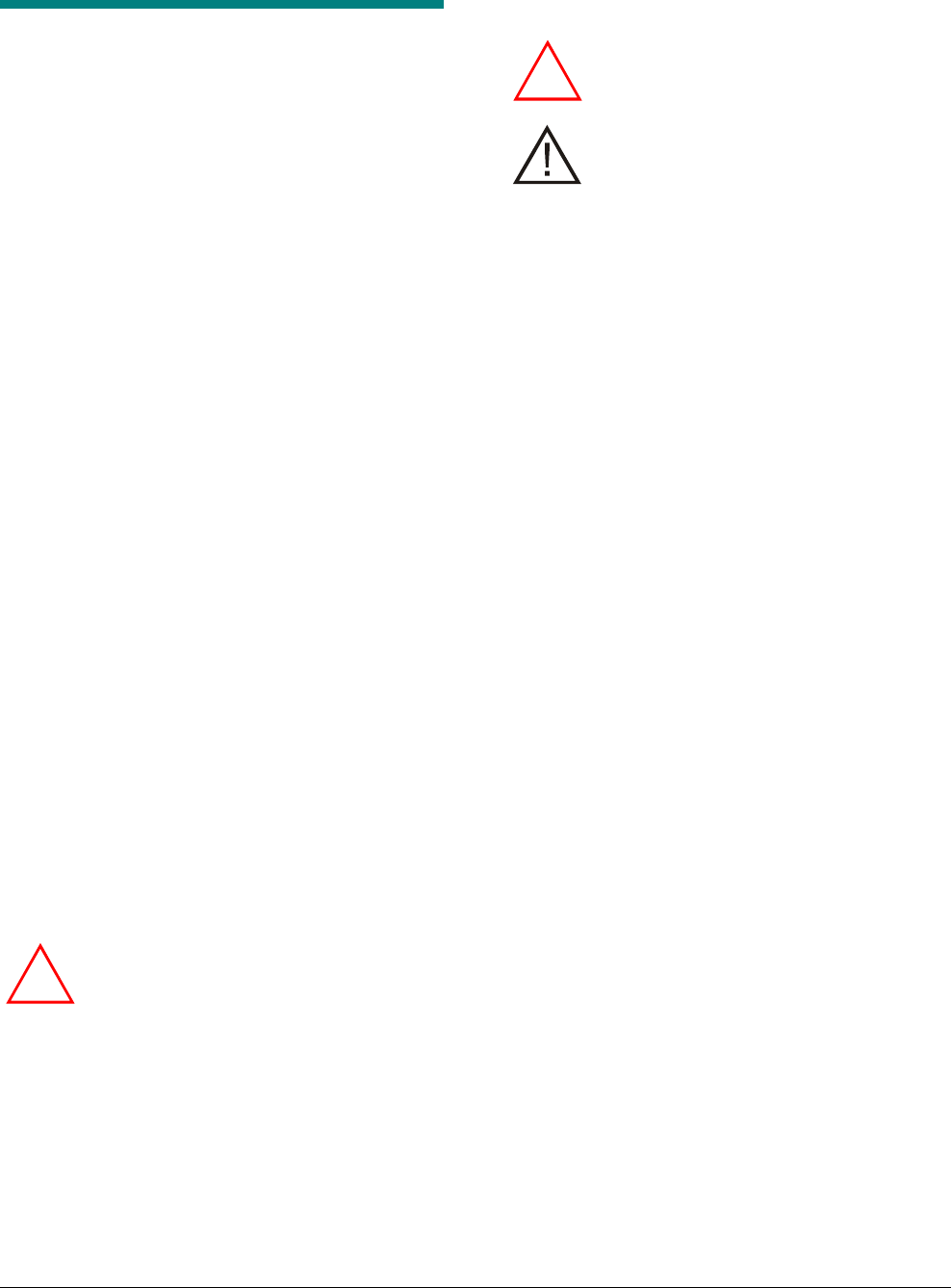
AMS-1080 DETECTION SYSTEM 8200-0418-01, REV. A
INSTALLATION AND SERVICE GUIDE 8 of 18
Installation Requirements
Verifying Equipment and Unpacking
- Verify that all equipment has arrived. Ensure the
system configuration is correct for the
installation site.
- Unpack major components in a back room. At
the install site, lay out parts in the order you will
need them. Do not clutter the aisle or cause a
trip hazard.
Installer/Contractor
- Have electrical work comply with the latest
national electrical code, national fire code, and
all applicable local codes and ordinances.
- Coordinate work with other trades to avoid
interference.
- Verify existing site conditions and coordinate
with the owner’s representative and appropriate
utilities as required.
- Obtain copies of all related plans, specifications,
shop drawings and addenda to schedule and
coordinate related work.
- Thoroughly review the project to ensure that all
work meets or exceeds the above requirements.
Bring alleged discrepancies to the attention of
Sensormatic Electronics.
Controller Requirements
- The controller has a built-in flange used to
attach the controller to metal, wood, or drywall
using suitable hardware. The wall and hardware
must support 13.3kg (29.4 lbs) or four times the
weight of the controller assembly.
- Do not mount controller with its fan facing up.
The fan must be set to the operating voltage
using jumpers inside the controller.
WARNING! Do not install this device
where highly combustible or explosive
products are stored or used.
AMS-1080 Antenna Requirements
WARNING! Do not install this device
where highly combustible or explosive
products are stored or used.
CAUTIONS:
- Each AMS-1080 antenna has a silver
label on one of its bottom side panels.
This label must face the counter for
single aisle installations, or “Aisle A1
or B1” for dual-aisle installations.
- When mounting the controller, power
cord, connectors and fan must face
down.
- Antennas furthest from the controller
require a trench to route cables to the
controller.
- Keep the surface of the AMS-1080
antenna at least 5cm (2in) from the
surface of a metal-sided counter.
- Cables are 7.6m (25ft). DO NOT
CUT! Shorter cables can reduce
operating performance.
Equipment Required
Basic setup requires the following equipment:
• AMS-1080 controller
• AMS-1080 antennas with counter mount
or pole mount hardware
• Ranger antennas (optional)
• Hard tag (non-deactivateable Ultra•Max tag)
• Ultra•Max low energy labels.
Advanced setup requires the following additional
equipment:
• Laptop with Windows® 95, 98, NT, 2000, or XP
operating software
• RS-232 Ultra•Max programming cable
• Service configurator software.
!
!
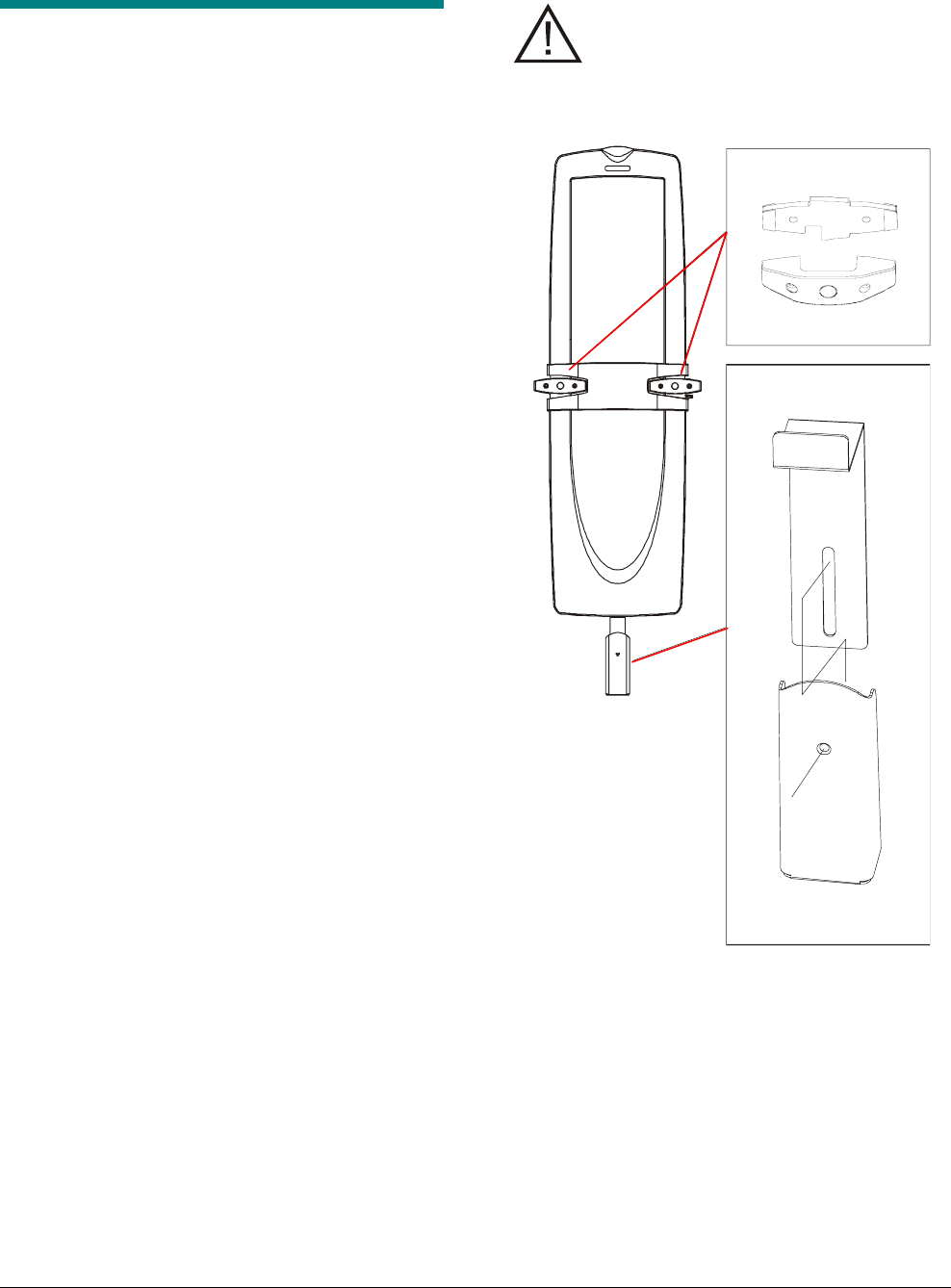
AMS-1080 DETECTION SYSTEM 8200-0418-01, REV. A
INSTALLATION AND SERVICE GUIDE 9 of 18
AMS-1080 Antenna
Installation
The AMS-1080 antenna can be mounted against a
wall or counter, or to a railing post.
Against a Wall or Counter
For this installation, the antenna is secured to the
floor and top edge of the checkout counter.
Tools required:
- Tape measure and level
- Pencil or marker
- Knife
- Electric drill and drill bits: 5.5mm (7/32in) masonry,
3.2mm (1/8in), 6.4mm (1/4in), and 9.5mm (3/8in)
- Phillips-head screwdriver or bit
- Hammer and nail set
- Hand vacuum or broom
- Pliers or 9.5mm (3/8in) wrench
- Wiremold (optional)
- Trenching tool such as a floor saw (if necessary).
Parts required:
Install Kit 0352-0199-01
Mounting base, antenna 1 0505-1022-01
Anchor with washer and nut 2 2880-0111-01
Bracket, antenna mounting base 1 0505-0872-01
Screw, Phillips, FH, M5 1 5801-3102-120
Washer, M5 1 5840-0400-020
Nut, locking, M5 1 5826-0400-011
Clamp, straight 2 0505-0184-01
Spacer (left) 1 0404-0229-01
Spacer (right) 1 0404-0229-02
Screw, M5x12 1 5801-3072-120
Screw, self-drilling, Phillips, M4 2 5899-0031-05
Screw, Phillips, M5x50 2 5801-3151-111
Washer, floating, M5 2 5842-0400-020
Washer, locking, M5 2 5847-0400-020
Nut, M5 2 5827-0400-020
Spacer Kit 0352-0205-01
Spacer (left) 2 0404-0229-01
Spacer (right) 2 0404-0229-02
IMPORTANT! Keep the antenna at least
5cm (2in) from metal surfaces. As
necessary, add spacers and adjust the
mounting base assembly to maintain this
separation.
Clamp
Mounting Bracket
Mounting Base
Spacer
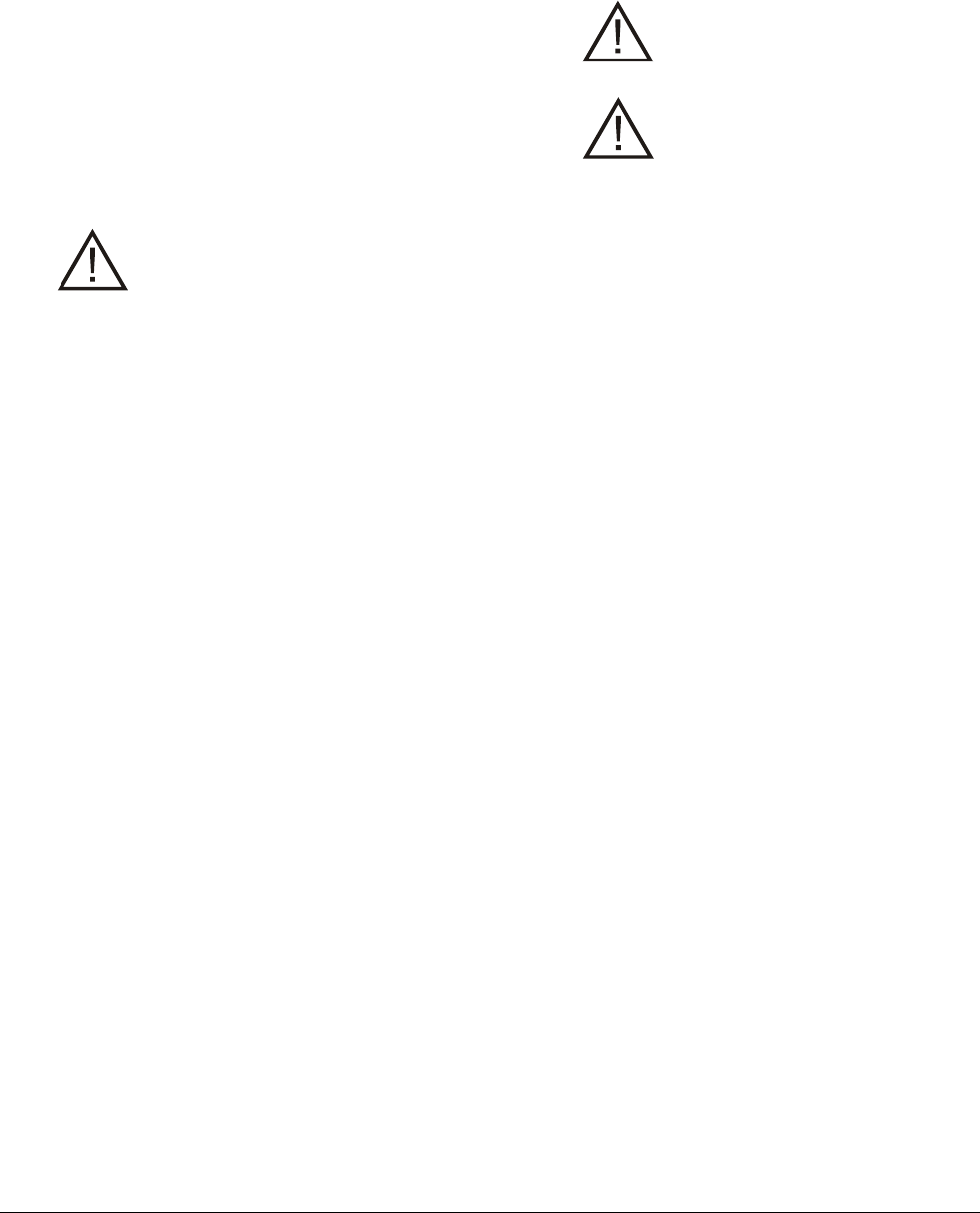
AMS-1080 DETECTION SYSTEM 8200-0418-01, REV. A
INSTALLATION AND SERVICE GUIDE 10 of 18
PROCEDURE
1. A label is on a bottom side panel of the AMS-
1080 antenna. The label must face the counter.
2. Attach antenna clamps.
a. Position clamps in the spaces on the
antenna designated for them.
b. A right and left spacer are provided. Press
the adhesive side of a spacer against each
clamp to hold them in place.
Note: Each spacer has a cable notch; cables
exiting the antenna pass through this notch.
If the antenna must be further from the wall
or counter, add more spacers.
IMPORTANT! Keep the antenna at
least 5cm (2in) from metal surfaces.
3. Mark mounting-screw hole locations.
a. Build the mounting base assembly by
attaching the antenna mounting bracket to
the top of the mounting base using an M5
screw, washer, and locking nut. With the
mounting base assembly in its installation
position, the bends at the top of the bracket
must face away from the counter.
b. To place antenna clamps at the proper
mounting height, temporarily insert the top of
the mounting base assembly into the slot in
the bottom of the antenna. Then holding the
antenna clamps against the counter, and
with the antenna level, mark hole locations:
• In the counter for screws that will secure
the clamps,
• Directly behind the cable notch in the
spacer where cables exit the antenna,
• On the floor for two anchors that will
secure the mounting base.
c. Remove the antenna and mounting base
assembly.
4. Drill mounting holes.
a. Using a 5.5mm (7/32in) masonry bit, drill two
holes in the floor 54mm (2-1/8in) deep for the
anchor bolts.
CAUTION: If carpet exists, use a
knife to remove it from under the
mounting base to prevent carpet
runs caused by drilling.
IMPORTANT! Holes more than
60mm (2-3/8in) deep or less than
50mm (2in) deep may not secure
anchor bolts.
b. Directly behind the cable notch in the spacer
where cables exit the antenna, drill a 16mm
(5/8in) access hole in the checkout counter
for antenna cables to go to the controller.
c. Drill holes for screws that will secure clamps.
Note: If using self-drilling screws in sheet
metal, 3.2mm (1/8in) pilot holes may be
needed. Otherwise, drill a 6.4mm (1/4in) hole
for an M5 machine screw, washer, and nut.
5. Install the mounting base assembly.
a. Remove the nut and washer from each
anchor and insert the anchor into a hole until
it contacts bottom.
b. Using a hammer and nail set, strike the
anchor several times to secure it.
c. Secure the mounting base assembly to the
two protruding anchors using the washer and
nut just removed. Tighten the hardware.
6. Again, set the antenna assembly onto the
mounting base and ensure the antenna is level.
7. Route antenna cables through the hole to the
controller. Connect antenna cables to the
controller. DO NOT CUT CABLES!
8. Secure clamps to the wall or counter using self-
drilling screws or M5 machine screws, washers,
and nuts supplied.
9. If used, install Ranger antennas; otherwise, see
“System Setup” on page 13.

AMS-1080 DETECTION SYSTEM 8200-0418-01, REV. A
INSTALLATION AND SERVICE GUIDE 11 of 18
To a Railing Post
For this installation, the antenna is secured to a
railing post between two adjacent aisles.
Tools required:
- Two 3.2mm (1/8in) Allen wrench hex drivers
- Tape measure
- Pencil or marker
- Electric drill and drill bits: 5.5mm (7/32in) and 9.5mm
(3/8in)
- Phillips-head screwdriver or bit
- Hand vacuum or broom
- Trenching tool, such as a floor saw
Parts required:
Install Kit 0352-0198-01
Bracket, pole 4 0505-0570-01
Bushing, pole 4 0505-0571-01
Appliqué 4 0505-0572-01
Screw, M, PHP, M5x16 2 5801-3081-120
Washer, FL, M5 4 5840-0400-022
Nut, M5 2 5827-0400-020
Clamp, cable, 1/2in width, SS 2 6010-0122-01
PROCEDURE
1. Saw a 6.4mm (1/4in) wide, 19mm (3/4in) deep
trench into the floor between the railing post and
the counter where the controller is to be located.
2. With the label on the bottom side panel of the
antenna facing Aisle A1 or Aisle B1, with the
antenna parallel to the line of traffic and its
bottom 17.8cm (7in) from the floor, drill a 16mm
(5/8in) cable access hole in the railing post
directly opposite where cables exit the antenna.
CAUTION: Do not drill this hole
through the other side of the post.
3. Attach the pole bracket to the antenna.
a. Remove an M5x16 screw, washer, and nut
from the pole bracket and loosen the strap,
but be careful to keep the bracket assembly
together.
b. Slide the pole bracket down the post to align
the cable exit hole in the bracket with the
cable access hole in the post.
c. Spread the bracket assembly.
d. Insert the pole bracket into the part of the
antenna designated for it while routing
antenna cables into the access hole, down
inside the post, and into the trench.
e. Reattach the M5x16 screw, washer, and nut
and tighten the assembly.
f. With its screw tucked inside the pole bracket,
tighten the strap holding the bracket
together.
4. Remove the backing from the appliqué. Then
affix the appliqué over its matching recess in the
pole bracket to hide the hardware.
5. Repeat steps 3 and 4 to install a second pole
bracket about 15.2cm (6in) above the first.
6. Route antenna cables through the trench to the
controller. Connect antenna cables to the
controller. DO NOT CUT CABLES!
7. Install Ranger antennas.
Screw
Strap
Remove hardware
to attach
17.8cm (7in)
Trench
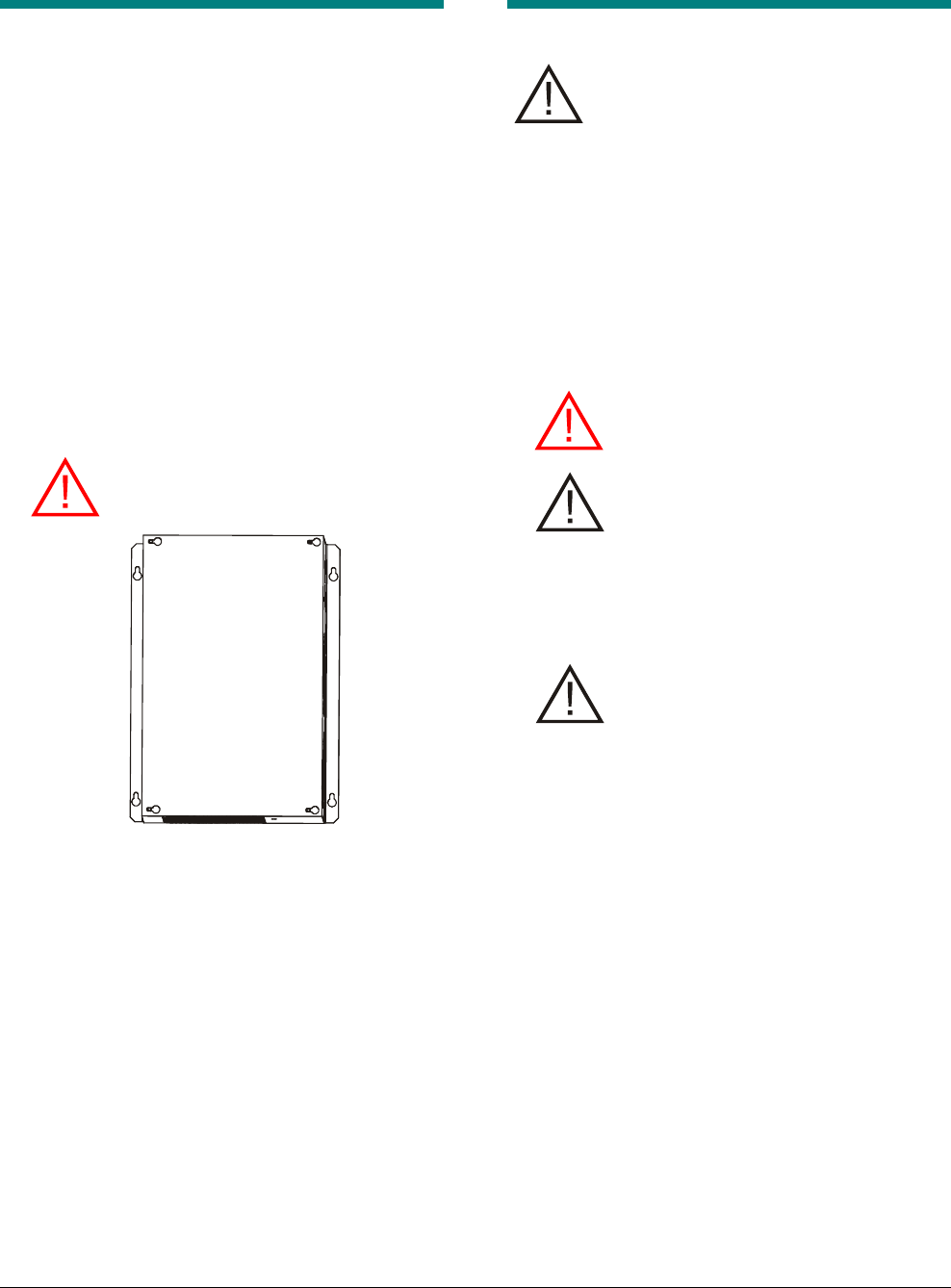
AMS-1080 DETECTION SYSTEM 8200-0418-01, REV. A
INSTALLATION AND SERVICE GUIDE 12 of 18
Controller Installation
Tools required:
- Tape measure
- Pencil or marker
- Electric drill and drill bits: 5.5mm (7/32in) and 9.5mm
(3/8in)
- Phillips-head screwdriver or bit
- Hand vacuum or broom
Parts required:
Install Kit 0352-0203-01
Screw, self-drilling, M4, 8x25, PHP 4 5899-0031-01
PROCEDURE
1. Set the controller on a shelf or mount it, with its
fan facing down, to a vertical surface using the
four self-drilling screws supplied.
WARNING! The vertical surface must
be able to support 13.3kg (29.4 lbs).
2. Referring to the diagram on page 4, attach
connectors to cables used for the installation.
3. Plug cables into the appropriate
connectors on the controller.
AC Hookup
CAUTION: Fan voltage is factory set
for 240Vac. If using 120Vac, remove the
cover from the controller and change fan
jumpers to 120Vac. See label inside the
controller for jumper locations.
PROCEDURE
1. Choose a power cord for the country of use.
Power cords come in .9m (3ft), 2.7m (9ft), 3.7m
(12ft), and 4.6m (15ft) lengths.
2. Plug in the power cord. The controller
automatically senses the voltage (100-120Vac
or 200-240Vac). No adjustments are required.
WARNING—RISK OF ELECTRIC
SHOCK! The ac power cord may carry
120Vac or 240Vac.
CAUTION: When using a power cord,
a socket-outlet must be installed near
the controller and in an easily
accessible location.
Für Installationen mit einem Stromkabel
muß die Steckdose an einem Standort
installiert werden, welcher einfachen
Zugang erlaubt.
CAUTION: A 10A, 2-pole, ganged
disconnect device, which also provides
short circuit and overload protection,
and has a minimum 3mm open circuit
clearance, in accordance with the
National Electric Code and applicable
local codes must be installed by a
licensed electrician at a location readily
accessible to the equipment.
Ein 10A, 2-poliges, gekoppeltes
Ausschaltgerät, welches auch über
einen Kurzschluß- sowie
Überbelastungsschutz verfügt, und
einen minimum 3mm offenen
Schaltabstand aufweist, nach
Übereinstimmung mit den Nationalen
Elektrischen Regelungen sowie
lokalen Regeln, muß an einem
Standort installiert werden, welcher
einfachen Zugang zum Gerät erlaubt.
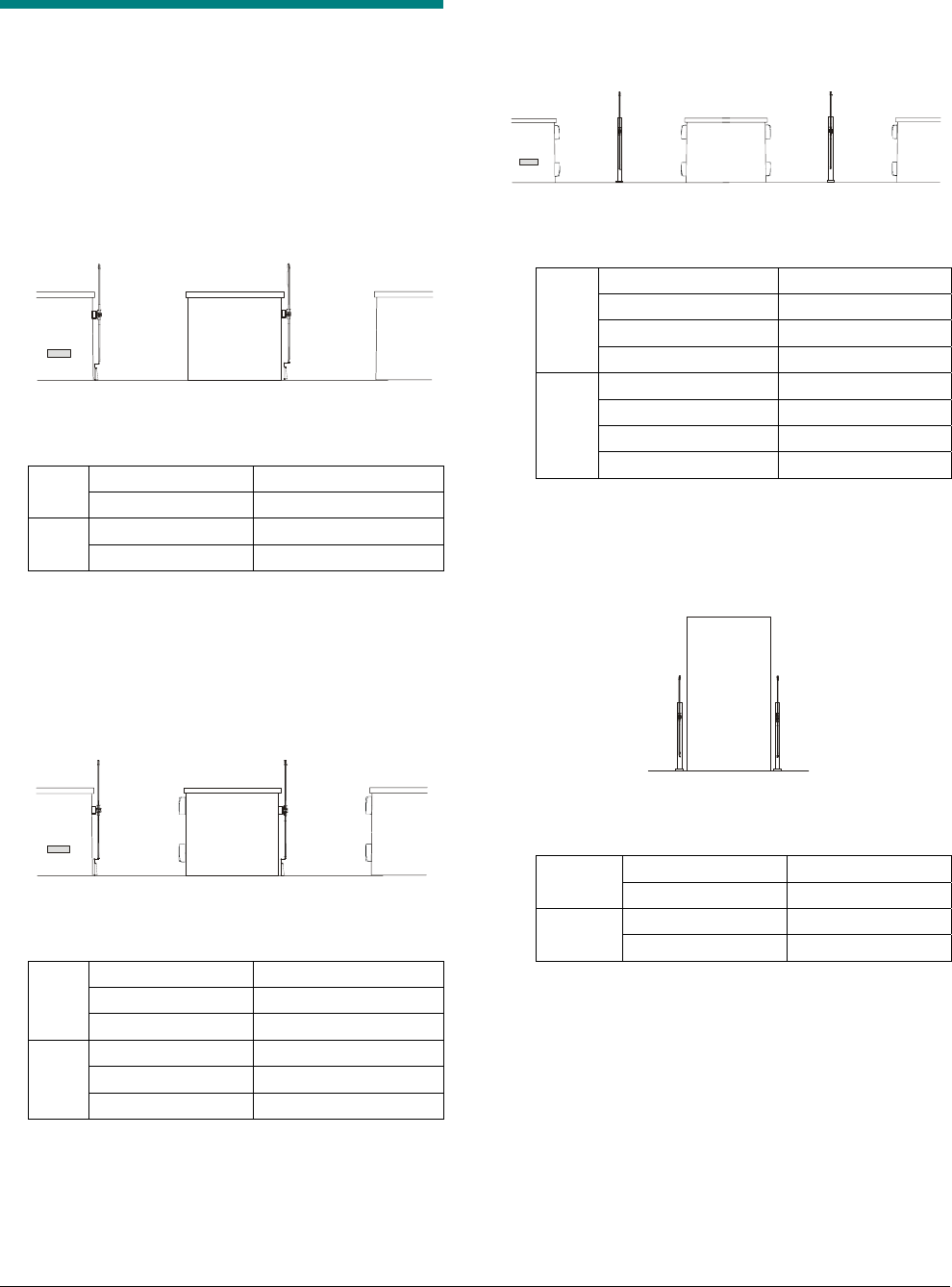
AMS-1080 DETECTION SYSTEM 8200-0418-01, REV. A
INSTALLATION AND SERVICE GUIDE 13 of 18
System Setup
Turn on the controller. Then connect antenna
cables and select software parameters as follows
for the type of antenna configuration installed.
Antenna Connections
- AMS-1080 antenna set up as a transceiver.
Connect antenna cables as follows:
Aisle Antenna Cables To Controller Port
AMS-1080 Tx Tx 1
A
AMS-1080 Rx/Alarm Rx 1/Alarm 1
AMS-1080 Tx Tx 2 B
AMS-1080 Rx/Alarm Rx 2/Alarm 2
- AMS-1080 antenna set up as a transceiver
with a pair of Ranger antennas.
- AMS-1080 antenna set up as a transmitter
for backfield reduction with a pair of Ranger
antennas.
Connect antenna cables as follows:
Aisle Antenna Cables To Controller Port
AMS-1080 Tx Tx 1
AMS-1080 Rx/Alarm Rx 1/Alarm 1
A
Ferrites (Rangers) Aux A
AMS-1080 Tx Tx 2
AMS-1080 Rx/Alarm Rx 2/Alarm 2
B
Ferrites (Rangers) Aux B
- AMS-1080 antenna set up as a transmitter
and positioned between two adjacent aisles
for zone detection.
Connect antenna cables as follows:
Aisle Antenna Cables To Controller Port
AMS-1080 Tx Tx 1
AMS-1080 Rx/Alarm Alarm 1 only
A1 Ferrites (Rangers) Rx 1
A1/A2
A2 Ferrites (Rangers) Aux A
AMS-1080 Tx Tx 2
AMS-1080 Rx/Alarm Alarm 2 only
B1 Ferrites (Rangers) Rx 2
B1/B2
B2 Ferrites (Rangers) Aux B
- Two AMS-1080 antennas set up at a doorway
either in the transmit-receive or transceiver
configuration.
Connect antenna cables as follows:
Antenna Antenna Cables To Controller Port
AMS-1080 Tx Tx 1
Right
AMS-1080 Rx/Alarm Rx 1/Alarm 1
AMS-1080 Tx Tx 2 Left
AMS-1080 Rx/Alarm Rx 2/Alarm 2
A B
A1/A2 B1/B2 A1/A2 B1/B2
A B

AMS-1080 DETECTION SYSTEM 8200-0418-01, REV. A
INSTALLATION AND SERVICE GUIDE 14 of 18
Software Selections
Note: Software parameters are selected using
AMS-1080 service configurator software. Only
selections pertaining to a basic system setup are
covered here. For additional information on
software parameters and how to use the
configurator, click Help in the service configurator.
On the service configurator, select the following for
each aisle or doorway:
Software Parameter Select/Adjust
System Configuration See below*
Aisle A/B See below**
Audio Volume, Duration, and
Inhibit Time. Enable
Jammer Event Trigger if a
58kHz jammer is used.
Lamp Duration and Inhibit Time.
Enable Jammer Event
Trigger if a 58kHz jammer
is used.
Current Adjust Set as required.
Misc. Tx Settings Ant A/B Polarity and Tx
Frequency
* Select “Individual Aisle Config” if AMS-1080
antenna(s) are to be set up in a checkout aisle.
Select “Alternating” or “Dual Transceiver” if AMS-1080
antenna(s) are to be set up at a doorway. “Alternating”
enables two AMS-1080 antennas to alternate between
transmit and receive with one antenna being the
transmitter and the other the receiver. “Dual
Transceiver” enables two AMS-1080 antennas to be
transceivers. Both antennas alarm simultaneously.
** This selection is only available when “Individual Aisle
Config” is selected. Set Aisle A or B to one of the
following:
a. None (no antenna enabled, do not select).
b. Transceiver. Select if an AMS-1080 antenna is the
only antenna to be used in the aisle.
c. Transceiver–Ferrite. Select if an AMS-1080
antenna is set up as a transceiver and two Ranger
antennas set up as receivers in the aisle.
d. Backfield Reduction. Select if an AMS-1080
antenna is set up as a transmitter and two Ranger
antennas set up as receivers in the aisle.
e. Dual Aisle Zone Detect. Select if an AMS-1080
antenna is set up as a transmitter on a railing post
between two adjacent aisles with a pair of Ranger
antennas in each aisle for alarm zone detection.
The alarm lamp lights in the aisle the tag/label was
detected in.
Verifying Operation
Check that the AMS-1080 antenna alarm lamp
lights when a tag/label is passed through the
checkout aisle, or if the system is covering
adjacent aisles, that the lamp lights only in the aisle
the tag/label was in.
If the pick rate is acceptable, fill the cable trench.
Installation is complete.

AMS-1080 DETECTION SYSTEM 8200-0418-01, REV. A
INSTALLATION AND SERVICE GUIDE 15 of 18
Troubleshooting
System Status Alert Codes
The Status LED on the controller displays system
status alert codes. When an alert code occurs, the
LED changes color and pattern. Red is used for
serious alerts while yellow is used for those less
serious.
a. The number of red flashes identifies a digit in a
two-digit alert code (for example, four flashes is
the number four). The start of an alert code is
indicated by a long LED interval. Then the first
digit of a two-digit error code occurs, followed by
a short delay, followed by the second digit.
b. See the table opposite for the significance of the
alert code. Most alert codes are automatically
resolved.
c. Some codes can only be accessed using the
service configurator. They are not displayed by
the Status LED.
d. Alert codes are lost when the controller is reset.
Code storage has a time stamp in days, hours,
minutes, seconds, milliseconds/ ticks of when
the system alert occurred.
The following critical faults are backed with
hardware support and provide the necessary action
when encountered.
- Current fault 1 per channel
- Ambient temperature fault
- Primary current fault
- Secondary current fault
- Last resort current fault to maintain Class 2
wiring requirements.
Alert codes repeat until the condition is resolved or
a timer resets the system.
Alert Codes
Alert Code Significance
11 Illegal Instruction Return controller
12 Unimplemented Interrupt Return controller
13 NVM Write Failed Return controller
14 Invalid Device Return controller
15 Sequence Table Error Return controller
16 Out of Memory Return controller
17 Undecided: No Split Return controller
18 Watchdog: Task Reset Return controller
21 AntA S/W Current Fault Recoverable
22 AntB S/W Current Fault Recoverable
25 H/W Current Fault Recoverable
26 AntA Current Sense Fault Recoverable
27 AntB Current Sense Fault Recoverable
39 Sequence Table Mismatch Recoverable
41 Missing Zero Crossing Return controller
42 Wired Sync: Missing Signal Recoverable
43 Temperature Fault Recoverable
44 S/W Temperature Fault Recoverable
45 PWM Fault Return controller
46 Fan Fault Recoverable
49 Realtime Error Return controller
51 Autosetup Owner Timeout Recoverable
52 Autosetup Release W/O Lock Recoverable
53 Autosetup Buffer Overrun Recoverable
54 Autosetup Mailbox Full Recoverable
56 Notch Select Timeout Recoverable
57 Window Select Timeout Recoverable
58 Autosetup Illegal Owner Recoverable
61 Detector Overrun Recoverable
62 Alarm Mailbox Full Recoverable
63 Host Comm Mailbox Full Recoverable
64 Host Comm Mailbox Full Recoverable
71 Host Comm Mailbox Full Recoverable

AMS-1080 DETECTION SYSTEM 8200-0418-01, REV. A
INSTALLATION AND SERVICE GUIDE 16 of 18
Local Diagnostics
The AMS-1080 controller enables you to
troubleshoot and change controller parameters
using your laptop computer and the AMS-1080
service configurator.
The following hardware is required:
• Laptop computer
• Service cable with a male RJ-10/22 phone connector
on one end and a male RJ-11/12 connector on the
other
• DB-9-to-RJ-11/12 connector.
How to Connect Cables
1. Connect the DB-9-to-RJ-11/12 connector to
the DB-9 serial port on your laptop computer.
Only pins 2, 3, and 5 are used.
2. Connect the RJ-11/J12 connector of the
service cable to the DB-9 connector and the
RJ-10/J22 connector on its other end to the
RS-232 port (RJ-10/22) on the controller.
Remote Diagnostics
The AMS-1080 controller enables you to use an
RS-485 network to troubleshoot and change
controller parameters from a remote site. To
connect to the network, connect the laptop, modem
and accessories as shown below.
DB9
RJ-11/J12
RJ-10/22 to
RS-232 port on
controller
DB-25 male to DB-9
male adapter
Null modem adapter
T adapter
Modem
RS-232/RS-485
converter
Controller
RS-485 port
Laptop

AMS-1080 DETECTION SYSTEM 8200-0418-01, REV. A
INSTALLATION AND SERVICE GUIDE 17 of 18
Fuse Replacement
The controller has two 2A, 250V slow-blow fuses in
the IE320 ac receptacle.
1. Pry the rectangular cover plate from the ac
receptacle using a small slotted screwdriver.
Two spring-loaded fuses should pop out.
2. Replace the blown fuse (or fuses) with 2A,
250V slow-blow fuses (P/N 5111-0028-07).
Specifications
Electrical
POWER SUPPLY
Primary input............................ 100-120Vac or
200-240Vac @ 50–60Hz
Primary power fuse .................. 2A, 250V, slo-blow,
hi-breaking
Current draw ............................ <1.0Arms @ 120Vac
Input power .............................. <100W
TRANSMITTER
Operating frequency................. 58kHz (±200Hz)
Transmit burst duration ............ 1.6ms
Transmit current maximum ...... 15A peak
Burst Repetition Rate:
Based on 50Hz ac.................... 75Hz or 37.5Hz
Based on 60Hz ac.................... 90Hz or 45Hz
RECEIVER
Center frequency...................... 58kHz
Environmental
Ambient temperature................ 0°C to 50°C
(32°F to 122°F)
Relative humidity...................... 0 to 90%
non-condensing
Mechanical (AMS-1080 Controller)
Length ...................................... 37.3cm (14.7in)
Width........................................ 27.8cm (10.9in)
Height....................................... 13.4cm (5.3in)
Weight...................................... 3.33kg (7.34 lbs.)
Mechanical (AMS-1080 Antenna)
Thickness................................. 3.6cm (1.4in)
Width........................................ 36.4cm (14.3in)
Height....................................... 121.3cm (47.8in)
Weight...................................... 5.2kg (11.5 lbs.)
Fuses (2)

AMS-1080 DETECTION SYSTEM 8200-0418-01, REV. A
INSTALLATION AND SERVICE GUIDE 18 of 18
Declarations
ASAISLE REG ID: AMS-1080 ANT
ZKRANGER-DG REG ID: UM UPFAF
Regulatory Compliance
EMC...............................47 CFR, Part 15
EN 300330-1 U1.3.2 (2002)
ETSI EN 300330-2 V1.1.1
(2001-06)
ETSI EN 301489-3 V 1.4.1
(2002-08)
ETSI EN 301489-1 V 1.4.1
(2002-08)
RSS210
Safety ............................UL 60950
CSA C22.2 No 60950
EN 60950
FCC COMPLIANCE: This equipment complies with Part 15
of the FCC rules for intentional radiators and Class A digital
devices when installed and used in accordance with the
instruction manual. Following these rules provides reasonable
protection against harmful interference from equipment
operated in a commercial area. This equipment should not be
installed in a residential area as it can radiate radio frequency
energy that could interfere with radio communications, a
situation the user would have to fix at their own expense.
EQUIPMENT MODIFICATION CAUTION: Equipment
changes or modifications not expressly approved by
Sensormatic Electronics Corporation, the party responsible for
FCC compliance, could void the user's authority to operate the
equipment and could create a hazardous condition.
Other Declarations
WARRANTY DISCLAIMER: Sensormatic Electronics
Corporation makes no representation or warranty with respect
to the contents hereof and specifically disclaims any implied
warranties of merchantability or fitness for any particular
purpose. Further, Sensormatic Electronics Corporation
reserves the right to revise this publication and make changes
from time to time in the content hereof without obligation of
Sensormatic Electronics Corporation to notify any person of
such revision or changes.
LIMITED RIGHTS NOTICE: For units of the Department
of Defense, all documentation and manuals were developed at
private expense and no part of it was developed using
Government Funds. The restrictions governing the use and
disclosure of technical data marked with this legend are set
forth in the definition of “limited rights” in paragraph (a) (15)
of the clause of DFARS 252.227.7013. Unpublished - rights
reserved under the Copyright Laws of the United States.
TRADEMARK NOTICE: Sensormatic is a registered
trademark of Sensormatic Electronics Corporation. Other
product names mentioned herein may be trademarks or
registered trademarks of Sensormatic or other companies.
No part of this guide may be reproduced in any form without
written permission from Sensormatic Electronics Corporation.
MDR 08/2004